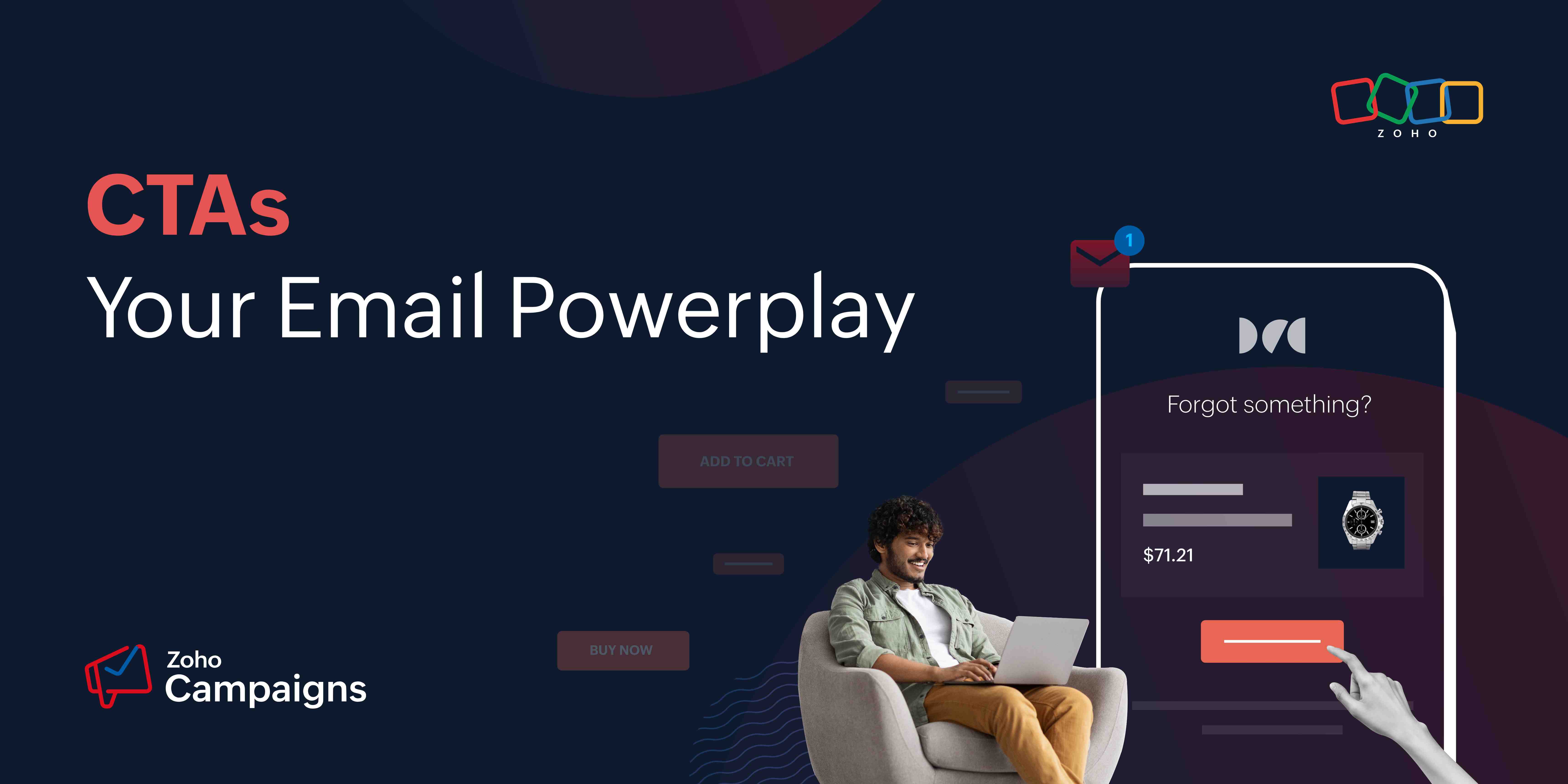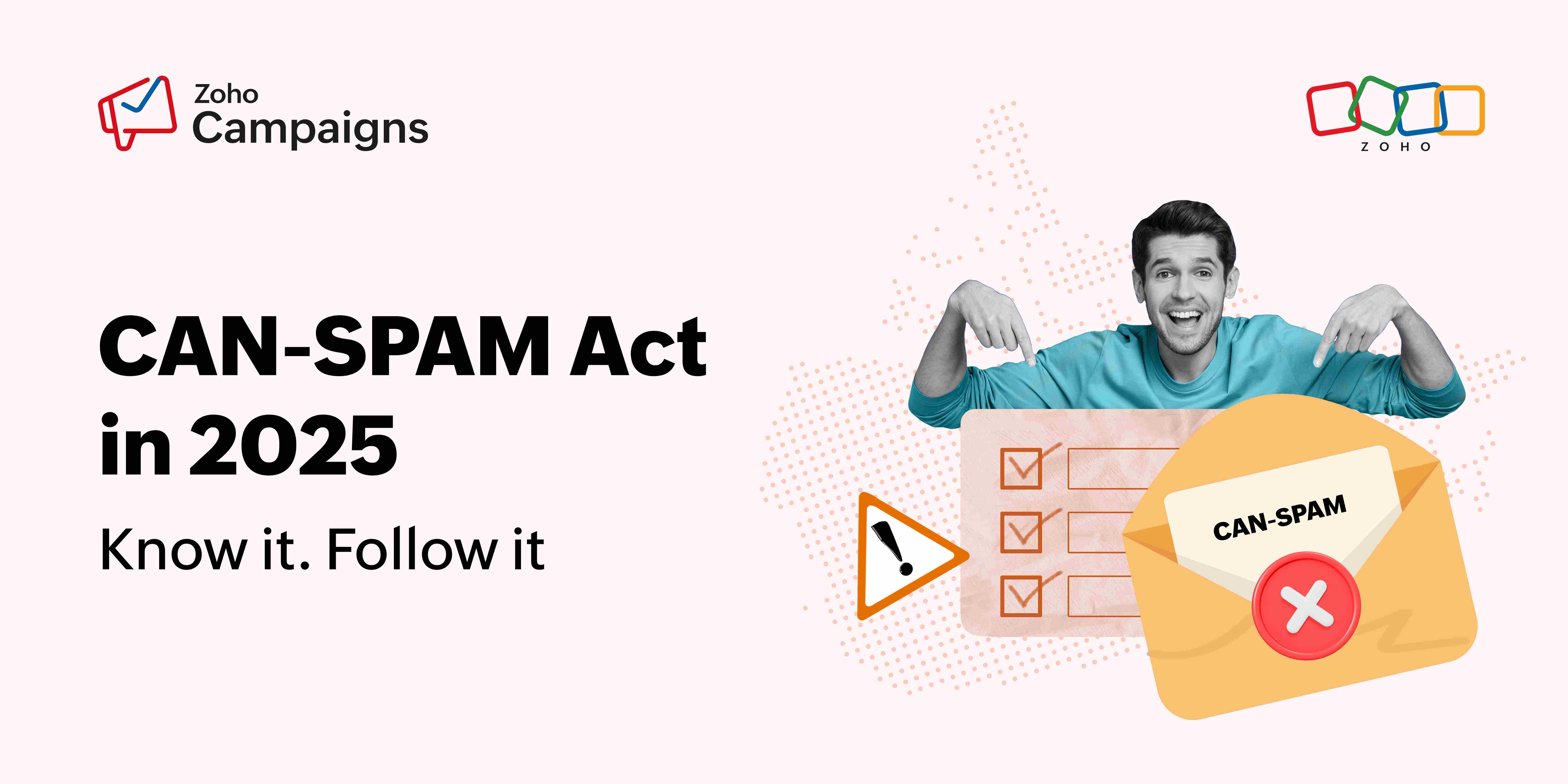- HOME
- Email Marketing
- From clicks to customers: The CTA strategies that actually work
From clicks to customers: The CTA strategies that actually work
- Last Updated : March 12, 2024
- 688 Views
- 14 Min Read

What can turn a simple email into a powerful tool of engagement and action? The answer lies in three little words: Call to Action (CTA).
Imagine, for a moment, the journey of an email in your subscriber's inbox. It starts with a standout subject line, which is then bolstered by engaging content—but then, without a CTA, it abruptly ends. A well-placed CTA offers a clear pathway forward, whether it's to explore a new feature, start a free trial, or dig deeper into insightful content.
Given that the average person's attention span for an email is as low as nine seconds, it's important to get the CTA right.
A good CTA drives engagement and conversion
Without a clear call to action, your subscribers might be interested but unsure what to do next. A well-crafted CTA removes the guesswork and thereby increases engagement and conversions.
It shapes the customer journey
CTAs guide subscribers through the sales funnel, directing them towards specific actions that move them closer to becoming paying customers or loyal brand advocates.
It helps you measure success
By tracking click-through rates on your CTAs, you gain valuable insights into the effectiveness of your email campaigns and can make data-driven decisions for future efforts.
Effective strategies for crafting high-impact CTAs
Creating high-converting CTA requires a blend of creativity, clarity, and strategic thinking. Let's first look at a structured approach to crafting CTAs that can significantly enhance your email marketing outcomes:
Set a clear goal
The first and most important task is to clearly define what you want to achieve with your CTA. Whether it's driving traffic to your website, generating leads, or closing sales, your goal should dictate the design, content, and placement of your CTA.
Understand your audience and personalize
Once you've defined your goal, the focus should be on the personalization of CTAs to keep it relevant for your target audience. You need to have a deep understanding of your target audience's preferences, pain points, and behavior to be able to personalize the CTAs. Well-conceived segments based on past behavior will help you automate that process. Personalization and relevance are key to increasing the likelihood of engagement.
Use action-oriented language
Use strong, verb-centric phrases that encourage immediate action. Words like "download," "subscribe," "join," and "buy" are direct and leave no ambiguity about what action you want the user to take.
Design for visibility
Ensure your CTA stands out visually. Use contrasting colors, appropriate sizes, and the right amount of white space so the CTA is immediately noticeable without overshadowing the rest of your content.
Place it strategically
You may come across this famous brainteaser activity every so often on social media:

The brainteaser exploits the way your attention and visual perception work. It demonstrates a fundamental principle of design and communication: You can guide the viewer's attention involuntarily along a narrative or hierarchy of information simply through the strategic use of visual cues.
When it comes to placing CTAs in emails, this principle is equally powerful. So as you determine where to place your buttons, keep your readers in mind. Arrange your copy and buttons in a way that encourages a natural reading flow that ultimately directs them to your CTA.
Using a contrasting color helps it stand out from the rest of the content.
Take inspiration from Zoho Campaigns's pre-designed templates and craft high-converting email campaigns.
Embrace emotional triggers
Think about sparking a sense of urgency ("Grab your spot before it's too late!") or using exclusivity ("An offer just for you"). It's all about stirring up those emotions and making your audience feel like they're missing out if they don't click. Tailor these emotional hooks to fit snugly with your campaign's vibe and your audience's current mood.
Use time-sensitive language or offers to create a sense of urgency. Phrases like "Offer ends soon," "Limited availability," or "Act now" prompt quick responses.
Keep the messaging clear
Your CTA should be succinct. Avoid jargon or complex language that might confuse your audience.
Optimize for mobile
With more and more users accessing emails on their mobile devices, ensure your CTA is easily clickable on any screen size. A touch-friendly design with a clear call to action is essential.
Test and optimize
Test. Analyze. Refine. Repeat. Your CTAs aren't set in stone. Use A/B testing to keep your CTAs fresh and effective. Think of it as a continuous improvement for your click-through rates. Don't settle for your first draft. Use A/B testing to try out different versions of your CTA and see which performs best. Test different texts, colors, placements, and sizes to improve your click-through rates continuously.
Implementing the right call-to-action strategies can significantly influence your marketing goals by guiding potential customers through the sales funnel and encouraging specific actions.
Underused CTA strategies
Text CTAs
Ever since CTA buttons became prominent, text CTAs have often been considered boring, ineffective, and maybe even a lazy alternative for marketers who are pressed for time. But what if there's still demand for textual CTAs, and that it involves using hyperlinked text instead of button-based CTAs?
Text CTAs work for informational emails like newsletters and product/policy updates that take the form of personalized correspondence. They also work well as secondary CTAs, offering additional options for engagement beyond the primary button-based CTAs.
For example, if you're sending an email promoting a new blog post, a textual CTA could be a sentence that reads "Dive deeper into our analysis of the latest market trends here," with "here" being a hyperlink to the blog post.
This method offers a seamless reading experience. The goal is to provide a less disruptive and more content-focused pathway for the reader to follow, and to encourage them to explore further without feeling like they're being overtly sold to.
CTAs in email signatures
Consider using the often-overlooked email signature space for CTAs. It could be as simple as encouraging your recipient to visit a website, view your profile or social media handle, or share an invite for an upcoming event or webinar. The best part about having a CTA in your email signature is the versatility it offers; you can tailor it for lead generation, social engagement, or content sharing.
Most of the time, email signatures give your email an air of trust and authenticity. That's why including a link to your website or adding a calendar invite may work well there; it establishes you as an authority.
But hey—if you do consider using a CTA in your email signature, don't forget to create it in HTML to ensure it's compatible across email clients and devices.
Respectful and ethical CTAs
With stringent privacy laws in place (for good reason!), marketers should design CTAs that respect user autonomy and avoid manipulative tactics. Use straightforward language to avoid confusion, highlight genuine benefits without over-promising, and always be upfront about what clicking that button means.
Personalization and transparency aren't just nice-to-haves; they're essential for building trust and showing your audience you value their autonomy. Be the kind of marketer that respects the audience's choices and privacy. It's not just good ethics; it's good business. And at Zoho Campaigns, privacy comes first—always.
Image-linked CTAs
There's something satisfying about clicking on images, which is why people like it. Link images in your emails to relevant landing pages or blog posts to capitalize on this behavior. This can help improve conversion rates by offering a more visually engaging way to direct readers to your content.
Gamified or interactive CTAs
From spin-the-wheel games to interactive quizzes, these CTAs offer more than just a call to action; they provide an experience that can significantly boost engagement and conversions. Interactive elements like sliders, polls, and surveys serve as CTAs that not only drive action but also collect valuable user insights in a non-intrusive way.
One for the future: Voice-activated CTAs
We use voice assistants to guide us, read to us, play music, and even shop for us. As voice assistants become more integrated into our daily lives, it won't be long until voice-activated CTAs make it to email marketing.
Imagine your audience just saying out loud, "Hey Google, sign me up!"—and they're in. This is the future we're looking at, where your calls to action become as easy as a conversation. It's not just about keeping up with the latest tech; it's about making it super simple for people to connect with your brand. As voice technology gets more popular, using it in your emails could make your CTAs stand out. Make things easier and more natural for your audience by turning a simple command into a powerful action.
Bonus tip
Consider the accessibility of your CTAs. Try to make your CTAs accessible to all, including individuals with disabilities. This means going beyond the basics—think color contrast, legible fonts, and alt text for those eye-catching images. Ensuring that everyone can navigate, understand, and act on your CTAs makes your campaign a welcoming space for every potential click.
Effective CTA strategies for various marketing objectives
Lead generation
The goal here is to gather information from prospects to build your database for future marketing efforts. So boost your lead generation game with catchy CTAs!
Prompt signups with a simple "Sign up for free," hook your audience with must-have resources like "Download our free ebook," and reel them in with irresistible lead magnets—"Try it for free" or "Book your demo today."
Social sharing
For social sharing, expand your content's reach by getting your target audience to do your bidding with CTAs like "Spread the word" and "Share with your network." Highlight the joy of sharing with "Help others discover" and invite personal stories with "Tell your story." Every share is a personal endorsement that will help immensely with conversions.
Sales
When it comes to sales, CTAs are all about creating buzz. Examples like "Buy now to save!" or "Offer ends soon" can push your target audience to take immediate action. Sweeten the deal with "See the benefits" or offer peace of mind with a "Money-back guarantee."
Informational
For the information seekers, educate and enlighten with CTAs like "Learn more about this topic" or "Join our free webinar." Offer deep dives with "Download our free guide" and turn curious minds into potential leads.
Feedback collection
Feedback is your best source for customer insights. Encourage your audience to voice their opinions with a CTA like "Share your thoughts with us," or reward their time with prompts like "Take our survey and win." Keep it simple to encourage action.
Lead nurturing
Nurturing leads is a lot like tending a garden. Keep them thriving by giving them exclusive content or offering personalized care ("Get your custom recommendation"). Keep the conversation going with CTAs like "Stay updated with our latest". This ensures that your leads never feel forgotten.
Form submission
Form submissions should be a breeze. Link benefits directly with CTAs, like "Sign up and start learning," and make the process as easy as possible.
Service/product discovery
For those discovering your service/product, your CTA should spark the curiosity to click. Use a CTA like, "Explore our features" and offer hands-on experiences. Build trust by sharing customer success stories with a CTA like, "See how others succeeded."
Closing the sale
Closing the sale means making that final push. Reiterate the value on offer with CTAs like "Complete your purchase for lifetime access." CTAs like "Check out in just one click" can reduce perceived effort, making the purchase decision easier. Consider offering last-minute incentives ("Add to cart for an exclusive bonus"). This gives users an additional reason to complete their purchase now rather than later.
Event promotion
For event promotion, focus on CTAs that prompt immediate action, such as "Reserve your spot" or "Sign up for the event." Emphasize the exclusivity of the event with phrases like "Limited seats available—act now!" and pique interest by offering previews with "Get a sneak peek," and give attendees a glimpse into the event experience.
CTA cheat sheet for different marketing goals
Marketing goal | CTA 1 | CTA 2 | CTA 3 |
Lead generation | Sign up | Join free | Get started |
Social sharing | Share now | Tweet this | Post it |
Sales | Buy now | Shop here | Order today |
Informational | Learn more | Discover | Explore |
Feedback collection | Feedback | Survey | Tell us |
Lead nurturing | Stay updated | Follow us | Subscribe |
Form submission | Submit | Register | Apply now |
Service/product discovery | Discover | Find out | See more |
Closing the sale | Check out | Confirm | Finish |
Event promotion | Join now | RSVP | Book |
CTA strategies for different stages of the customer journey
The effectiveness of your CTAs doesn't just lie in the words you choose, but in the journey you craft for your audience. Each stage of the customer journey—awareness, consideration, decision, and post-purchase—requires a unique approach to ensure your message not only reaches your audience but also compels them to take action.
1. The awareness stage - Educate
At the outset of the journey, your potential customers are just getting to know your brand. They're gathering information, exploring their options, and aren't yet ready to make a purchase. Your goal here is to capture their attention and pique their interest in learning more about what you offer.
- Invite exploration: Use CTAs like "Learn more" to guide prospects gently towards comprehensive resources about your brand and offerings.
- Offer value: Encourage downloads of free guides or whitepapers through CTAs such as "Download the guide" to showcase your expertise and provide value upfront.
- Build connections: By using a CTA like "Subscribe for updates" or "Watch the video," you're inviting potential customers to engage with your content regularly and laying the foundation for a long-term relationship.
2. The consideration stage - Showcase benefits
As prospects move into the consideration stage, they're evaluating how your product or service stacks up against others; they're looking for reasons to choose you over the competition. Your CTAs here should focus on deepening their understanding of your value proposition and differentiating features.
- Demonstrate value: "Request a demo" or "free trial" CTAs can be incredibly effective in giving prospects hands-on experience with your product.
- Facilitate comparisons: Use "Compare plans" to guide prospects to clear, concise comparisons of your offerings and competitors' to highlight why you're the better choice.
- Provide personalization: "Get a quote" offers a personalized touch and shows prospects that you're ready to meet their specific needs.
3. The decision stage - Encourage commitment
By the decision stage, your prospects are on the cusp of making a purchase. They've recognized their need and believe your product can fulfill it. Now, your CTAs should focus on overcoming any last-minute objections and nudging them toward making that final commitment.
- Create urgency: "Limited-time offer" can spur prospects into action by emphasizing the deal's scarcity and time sensitivity.
- Simplify the action: "Buy now" or "Add to cart" CTAs should be straightforward, making the process of purchasing as easy as possible.
- Offer assurance: Risk-free trials or money-back guarantees—signaled through "Start your free trial"—can help alleviate any fears of commitment.
4. The purchase stage - Seal the deal
At the purchase stage, your potential customers have decided that your product or service meets their needs, and they're ready to buy. This critical juncture is where you need to make the purchasing process as seamless and reassuring as possible by eliminating any friction that could deter a final decision.
- Streamline the process: Ensure your "Check out now" or "Proceed to purchase" CTAs lead to a straightforward, easy-to-navigate checkout process. The fewer the steps, the better.
- Reassure security: Use CTAs like "Secure checkout" to reassure customers that their transaction and personal information are safe. Trust badges and encryption reminders can also be effective.
- Highlight support: "Chat with us for any questions" CTAs can be placed strategically to offer assistance, showing customers that help is readily available should they need it during the purchasing process.
- Offer flexibility: Provide multiple payment options with CTAs such as "Pay with credit card, PayPal, or Klarna" to cater to different preferences and make it easier for customers to complete their purchase.
5. The post-purchase stage - Foster loyalty and engagement
After the purchase, your focus shifts to increasing customer satisfaction, encouraging loyalty, and turning new customers into brand advocates. Your CTAs should aim to engage customers further and integrate them into your community.
- Encourage feedback: "Leave a review" not only provides you with valuable customer feedback but also helps build social proof.
- Build community: Invite new customers to "Join the community" or "Follow us on social media" to keep them engaged and part of your brand's ecosystem.
- Support: Offer easy access to support through "Get support" CTAs to ensure customers feel valued and supported post-purchase.
6. The re-engagement stage - Revitalize connection
After a period of inactivity, your goal is to re-engage past customers or prospects who haven't interacted with your brand for a while. This stage is crucial for reigniting their interest and bringing them back into the active customer fold.
- Spark curiosity: Use CTAs like "See what's new" or "We miss you! Check out our latest" to pique their interest with updates or new product launches.
- Offer exclusivity: "Exclusive offer for returning customers" can make them feel valued and special, encouraging them to revisit and shop.
- Encourage sharing: "Refer a friend and get a bonus" CTAs not only re-engage past customers but also turn them into brand advocates by involving their network.
CTA cheat sheet to use for different stages of a customer journey
1. Awareness | 2. Interest | 3. Consideration |
Learn more | Explore features | Request a demo |
Discover our story | See how it works | Download a product brochure |
Explore our products/services | Learn about benefits | Read industry reports |
Get started | Get a free trial | Sign up for a trial period |
Subscribe for updates | Request a demo | Watch in-depth videos |
Visit our website | Read customer stories | Schedule a consultation |
See what we offer | Check out our blog | Access free resources |
Request a demo | Subscribe to our newsletter | Compare us with competitors |
Discover the benefits | View our product catalog | Visit our knowledge base |
Download our guide/ebook | Attend a webinar | Ask us anything |
Take a survey/quiz | Get a quote | Try before you buy |
4. Purchase | 5. Post-purchase | 6. Re-engagement |
Buy now | Leave a review | Come back and save |
Add to cart | Refer a friend | Miss you! Check out what's new |
Check out now | Join our loyalty program | Claim your exclusive offer |
Complete your purchase | Follow us on social media | See our latest collection |
Secure your order | Access your account | Reactivate your account |
Place your order | View more products | Special offer just for you |
Order your [product/service] | Take our survey | Update your preferences |
Start your subscription | Read our usage tips | Join us again |
Claim your [product/service] | Get support | Rediscover our [product/service] |
Finalize your order | Renew your subscription | Unlock special benefits |
Final thoughts
Every email is an opportunity to engage, inspire, and convert. A well-constructed CTA can be the difference between a prospect and a loyal customer. In today's world, where we're bombarded with info left, right, and center, ensuring your message doesn't just get seen but also gets acted on is crucial.
This is where Zoho Campaigns come into play. With its A/B testing feature, you can play around with various CTAs to discover which ones truly resonate with your audience. The pre-designed templates are not just easy on the eyes but can also make your CTAs pop. You can also customize them to match your brand's vibe and theme. With the power of advanced segmentation, you can tailor your CTAs so they speak directly to what your audience needs and wants, giving your conversion rates a solid boost.
So stop struggling with low click-through rates; get started with Zoho Campaigns and see the difference effective CTAs can make!



